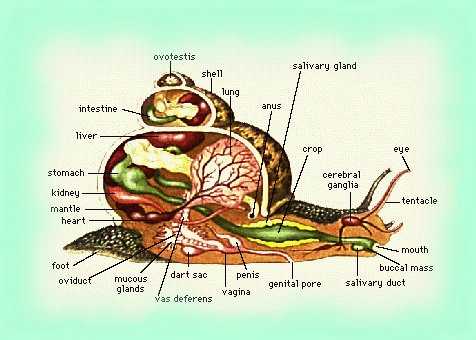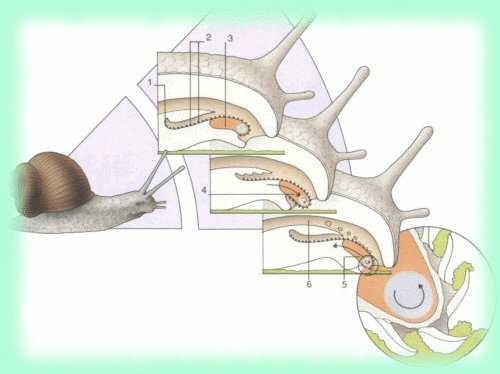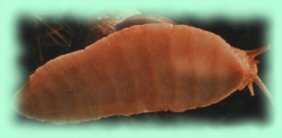| | | | Snails anatomy

The body of a
snail consists of foot (sole), a
head and a coiled visceral
mass that is located
in the shell. Movement
takes place by means of
expanding and extracting muscles in
the foot.
This is clearly visible when you place
a snail on a
glass surface, and look from below.
Mucus
glands located in the anterior(front)part
of the foot
secrete mucus. There are also mucus
glands on the rest of
the body protecting the
snail against loss of water.
Two
pairs of tentacles are placed on the head.
The upper pair
bears the eyes. The shell is secreted by a thick
fold of skin,called the mantle.
The shell is connected to the body throug a
strong muscle which is attached to the
columella.It has
branches to the head and tentacles.Contracting this muscle enables the
snail to withdraw in its shell. Inside
the shell it forms the mantle cavity,which holds the heart,kidney and
lung.
Snails
living on the land are uricotelic,this means that to preserve water
they excrete almost solid uric acid. Snails living in the water excrete
ammonia, and are not uricotelic.
The
radula:
The
mouth has a tongue called radula.In the top of the mouth is a hard
ridge and
food is being mashed between the radula and this
ridge.
 | 1: Rasp
Tongue (Radula)
2: Radula
Toothlets
3: Gristle
Core
4: Radula
is extended
5: Toothlets
are withdrawn
6: Food
is swallowed.
| | Image:
"Encyclopedia of nature", Munich, 2000 | |
The
reptation:
 | Snails
and slugs move by contracting and relaxing muscles in the foot. There
are two sets of muscle fibers,each performs a different task. When
moving forward one set contracts pulling the snail from the front and
pushing it off toward the back.At the same time the second set pulls
the outer surface of the sole forward. Both halves can move seperatly, creating a
sort of locomotion called reptation. |
| Source:
Arno Brosi | |
Glands
produce mucus which allows snails to move over rough or sharp material
and crawl on vertical surfaces. It's also used for protection and
navigation.Snail trails are broken while slug trails are continious.
| | | | | |